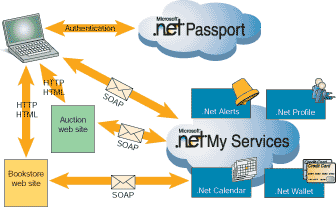What exactly is .NET?
One of the magazines I receive called Application Development Trends (www.adtmag.com), had an article written by David Chappell (www.davidchappell.com). The article was titled, One more time: What exactly is .NET? The article discussed the many reasons why Chappell felt the .NET name was dropped from most of the Microsoft lines. He also mentioned something very important. He said that Microsoft’s technology strategy has not changed. I would disagree.
Microsoft decided a few years ago that many of their products would bear the .NET branding name. Chappell did a great job of pointing these out: .NET Enterprise Servers (ie BizTalk and SQL), .NET My Services (ie Passport, .NET Alerts), Windows .NET Server, and Office .NET. .NET Enterprise Servers have recently been renamed to Microsoft Windows Server System Servers. Windows .NET Server was renamed last minute before release to Windows Server 2003. Office .NET is now Office 2003. Chappell mentioned that these all carried the .NET branding name since they were all to have something with web services. They all do, but just as he suggested, Microsoft changed the name to prevent the confusion and to maintain a consistent branding scheme. .NET My Services has not failed, as he said. Instead, .NET My Services just came too early. It’s a technology that is not here yet. Microsoft has not “officially” released the technology, formally known as Hailstorm. Instead, they offer it in a “limited” fashion. Notice in this diagram (by Fawcette - www.fawcette.com):

Currently, only .NET Alerts, .NET Passport, and MSN Messenger Connect have been implemented. You can find out more about .NET My Services by visiting www.netservicesmanager.com.
Now back to Microsoft’s technology strategy. Chappell said that it did not change. However, within the past 5 years, Microsoft has been attempting to secure their applications more and emphasize web applications. The past year alone has demonstrated both of these with the huge push with web services (UDDI) and the ISA server. Microsoft is also pushing .NET technology, not just the name. This has been demonstrated with the creation on the International .NET Association (INETA) and the big push to create .NET user groups.
Overall, the article was very informative and explained many key points. Chappell appears to have a good understanding about the marketing behind the .NET name and did an excellent job explaining the reasoning for the change of name. You can read the article by visiting http://www.adtmag.com/article.asp?id=8003.
 Jason N. Gaylord
Jason N. Gaylord


